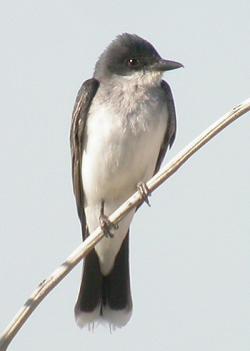Newsletters
Eastern Kingbird
A favorite summer Neo-tropical bird which nests across much of North America and winters primarily in the tropical forests of Ecuador and  Columbia in South America is the Eastern Kingbird. Along with its counterpart, the Western Kingbird, they are the largest of the tyrannus fly-catchers. They are a joy to watch launching off a perch such as a tree, fence or overhead lines hawking for insects, plucking them out of mid-air, then return to their perch to enjoy the feast before re-launching and repeating their task. The maneuvers of this Kingbird in flight are with great precision resembling a jet fighter pilot in a dog fight. They will dart, spiral, and hover, then in an instant make 180 degree turn. They are a joy to observe.
Columbia in South America is the Eastern Kingbird. Along with its counterpart, the Western Kingbird, they are the largest of the tyrannus fly-catchers. They are a joy to watch launching off a perch such as a tree, fence or overhead lines hawking for insects, plucking them out of mid-air, then return to their perch to enjoy the feast before re-launching and repeating their task. The maneuvers of this Kingbird in flight are with great precision resembling a jet fighter pilot in a dog fight. They will dart, spiral, and hover, then in an instant make 180 degree turn. They are a joy to observe.
Eastern Kingbirds breed in open habitats such as yards, fields, pastures, grasslands, or wetlands, and are especially abundant in open places along forest edges or water. They feed primarily on large and small flying insects during the breeding and nesting season, then feed on berries and fruits in their tropical winter range. They will hold larger insects with their beaks and beat them before swallowing them whole. When feeding bees and wasps to their young they will first remove the stinger.
They are a fairly easy bird to identify. Adult Eastern Kingbirds are a Robin size bird, 7 to 9 inches, with dark grey-black on the back and upper parts and very light under parts. The tail is long and black with white tips at the end. The wings span 13 to 15 inches and are pointed which aids in their maneuverability. Although seldom seen there is a red patch on the crown. This is where it gets the name Kingbird. When they encounter a predator they may expose this red crown patch of feathers, stretch their beak open revealing a red lining in the mouth, and repeatedly dive-bomb the intruder until they drive it off.
Eastern Kingbirds exhibit a rather aggressive behavior toward larger birds and predators that enter their territories or come near the nest. Tyrannus is latin for “tyrant, despot, king” which refers to their aggression. These Kingbirds will commonly attack much larger birds such as hawks, crows and ravens if threatened and even go after squirrels. They have been known to knock unsuspecting Blue Jays out of trees. Yet it is common to find them nesting within several feet of other birds such as Robins and Doves.
Eastern Kingbird’s are monogamous and the pair will defend their territory from other Kingbirds intruding or attempting to nest and both will aggressively defend their nest site. Males and sometimes females are very aggressive in territorial disputes with other Kingbirds, often resorting to aerial fights in which they lock feet together, pull out each other’s feathers, and sometimes fall to the ground.
The nest site is selected by the female with close scrutiny by the male. It may be in a shrub but more often is located in a tree. Some nests are very well concealed. The female Kingbird constructs a grassy cup nest that may have bits of paper or other foreign objects mixed in. A clutch of 2 to 5 smooth pale eggs with irregular reddish spots are laid and incubated entirely by the female for 14 to 17 days. She will remain on the nest except to chase off any predators that may approach. Once the eggs have hatched both the male and female will feed the young birds and continue feeding them for 4 to 7 weeks after leaving the nest. They will only produce one brood per season due to the length of time they spend caring for the young.
Kingbirds are “passerines” a term given to birds that perch, but are not considered a songbird. Their call is a high-pitched, buzzing and unmusical chirp, frequently compared to an electric fence. The young begin to give adult calls at about two weeks of age. They will use a variety of calls to communicate especially during the breeding season with the male calling more than the female. They will snap their bills at threats as well and make whirring sounds with their wings.
This is just one of the birds that travel thousands of miles from the tropics to spend the summer and nest in North America. They will only be here a few short months so we encourage you to watch for them and enjoy their aerial assaults on insects.
Wingtip: An Eastern Kingbird, banded at the Pioneers Park Nature Center by Irene Alexander, was later found dead on the banks of the Amazon River in South America.
